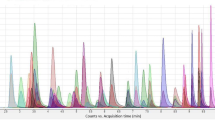Abstract
A detailed procedure for simultaneous analysis of morphine, codeine, 6-monoacetylmorphine, amphetamine, methadone, and its metabolite 2-ethylidene-1,5-dimethyl-3,3-diphenylpyrrolidine (EDDP) in human hair segments by liquid chromatography (LC)-atmospheric pressure chemical ionization (APCI)-tandem mass spectrometry (MS-MS) was established. Hair samples were pulverized and extracted with methanol. The blank hair obtained from healthy subjects showed no interfering impurity peaks. Good linearity was obtained for all compounds in the range of 0.2–20 ng/mg. Accuracy and precision data were also satisfactory. Using the established method, the opiates, amphetamine, methadone, and EDDP in hair segments were measured for 20 patients undergoing methadone therapy. Complete abstinence was achieved by only 6 of the 20 patients. Other patients failed to abstain from opiate(s) and/or amphetamine. Our data show that the present hair analysis of multiple drugs of abuse by LC-APCI-MS-MS is useful for monitoring the success or failure of methadone therapy.
Similar content being viewed by others
References
Targosz D, Sancewicz-Pach K, Szkolnicka B, Klys M (2004) Chemical poisonings among Kraków inhabitants. Przeg Lek 61:251–255
Targosz D, Sancewicz-Pach K, Szkolnicka B, Klys M (2005) Frequency and pattern of poisoning in adult and adolescent Kraków population in 2003 and 1983. Przeg Lek 62:446–452
Kala M (1997) Drugs of abuse in the practice of the Institute of Forensic Research in Krakow. Przeg Lek 54:430–437
Szukalski B (2005) Narcotics. Compendium of knowledge about drugs of abuse. Instytut Psychiatrii i Naurologii, Warsaw
Vetulani J (2002) Drug addiction. Part I. Psychoactive substances in the past and presence. Pol J Pharmacol 53:201–214
Robson PH (1997) Narcotics. Forbidden drugs: understanding drugs and why people take them. Medycyna Praktyczna, Kraków
Curran HV, Kleckham J, Bearn J, Strang J, Wanigaratne S (2001) Effects of methadone on cognition, mood and craving in detoxifying opiate addicts: a dose-response study. Psychopharmacology 154:153–160
Dyer KR, White JM, Foster DJ, Bochner F, Menelaou A, Somogyi AA (2001) The relationship between mood state and plasma methadone concentration in maintenance patients. J Clin Psychopharmacol 21:78–84
Kreek MJ (2000) Methadone-related opioid agonist pharmacotherapy for heroin addiction. History, recent molecular and neurochemical research and the future in mainstream medicine. Ann NY Acad Sci 909:186–216
Preston KL, Umbricht A, Epstein DH (2000) Methadone dose increase and abstinence reinforcement for treatment of continued heroin use during methadone maintenance. Arch Gen Psychiat 57:395–404
Sees KL, Delucchi KL, Masson C, Rosen A, Clark HW, Robillard H, Banys P, Hall SM (2000) Methadone maintenance vs 180-day psychosocially enriched detoxification for treatment of opioid dependence: a randomized controlled trial. J Am Med Assoc 283:1303–1310
Kintz P (2004) Value of hair analysis in postmortem toxicology. Forensic Sci Int 142:127–134
Kintz P, Tracqui A, Mangin P (1992) Detection of drugs in human hair for clinical and forensic applications. Int J Legal Med 105:1–4
Gaillard Y, Pepin G (1999) Testing hair for pharmaceuticals. J Chromatogr B 733:231–246
Suzuki O, Hattori H, Asano M (1984) Detection of methamphetamine and amphetamine in a single human hair by gas chromatography/chemical ionization mass spectrometry. J Forensic Sci 29:611–617
Miller ML, Donnelly B, Martz RM (1997) The forensic application of testing hair for drugs of abuse. NIDA Res Monogr 167:146–160
Moffat AC, Osselton MD, Widdop B (eds) (2004) Clarke’s analysis of drugs and poisons. Pharmaceutical, London, pp 124–134
Sachs H (1996) Forensic applications of hair analysis in drug testing. In: Kintz P (ed) Drug testing in hair. CRC, Boca Raton, pp 211–222
Sachs H, Kintz P (1998) Testing for drugs in hair. Critical review of chromatographic procedures since 1992. J Chromatogr B 713:147–161
Society of Hair Testing (2004) Recommendations for hair testing in forensic cases. Proceedings of the Third International Meeting of the Society of Hair Testing, 8–10 Oct 2003, Heraklion, Crete. Forensic Sci Int 145:83–84
Madea B, Musshoff F (eds) (2004) Haaranalytik, Technik und Interpretation in Medizin und Recht. Deutscher Ärzte, Köln
Goldberger BA, Darraj AG, Caplan YH, Cone EJ (1982) Detection of methadone, methadone metabolite, and other illicit drugs of abuse in hair of methadone-treatment subjects. J Anal Toxicol 22:526–530
Lucas ACS, Bermeho AM, Tabernero MJ, Fernandez P, Strano-Rossi S (2000) Uses of solid-phase microextraction (SPME) for the determination of methadone and EDDP in human hair by GC/MS. Forensic Sci Int 107:225–232
Paterson S, Cordero R (2003) Interindividual dose/concentration relationship for methadone in hair. J Anal Toxicol 27:20–23
Wilkins DG, Nagasawa PR, Gygi SP, Foltz RL, Rollins DE (1996) Quantitative analysis of methadone and two major metabolites in hair by positive chemical ionization ion trap mass spectrometry. J Anal Toxicol 20:355–361
Author information
Authors and Affiliations
Corresponding author
Rights and permissions
About this article
Cite this article
Kłys, M., Rojek, S., Kulikowska, J. et al. Usefulness of multiple opiate and amphetamine analysis of hair segments under methadone therapy using LC-APCI-MS-MS. Forensic Toxicol 25, 69–75 (2007). https://doi.org/10.1007/s11419-007-0030-x
Received:
Accepted:
Published:
Issue Date:
DOI: https://doi.org/10.1007/s11419-007-0030-x




